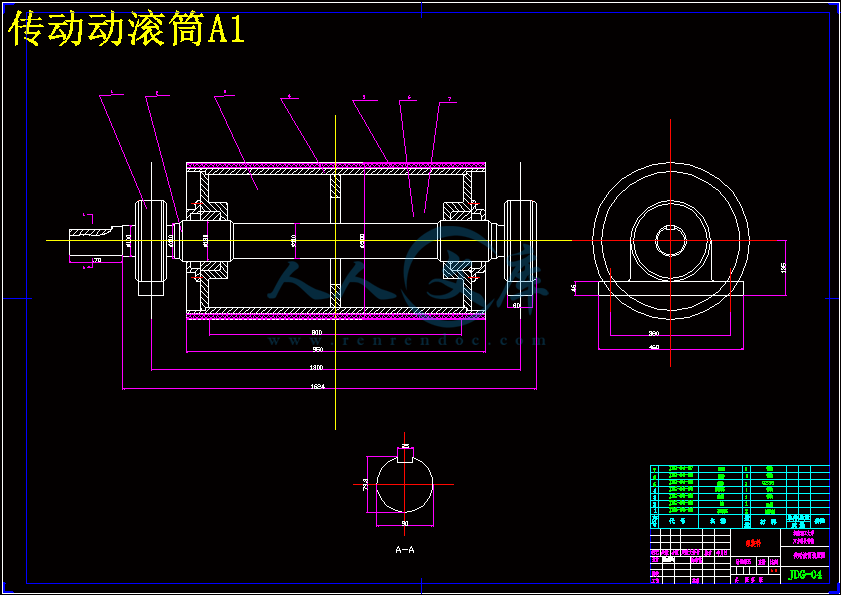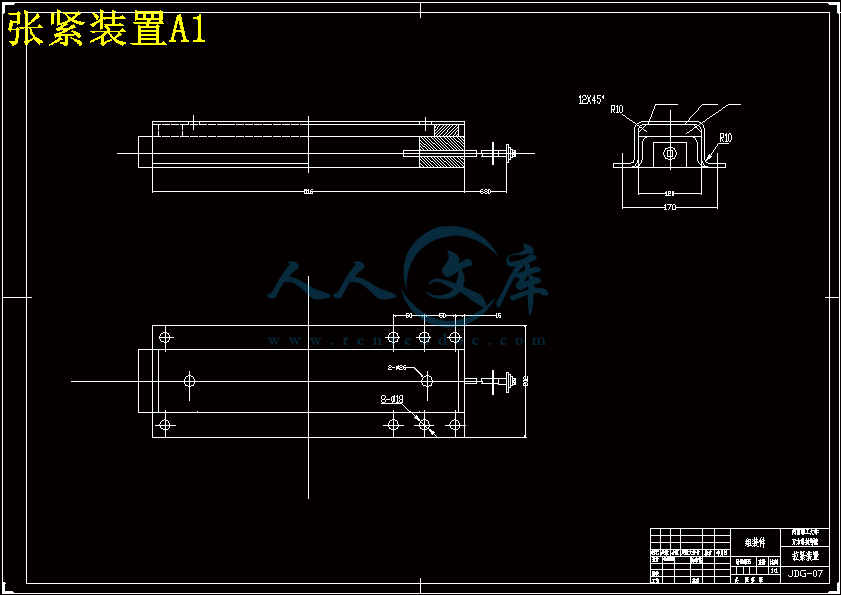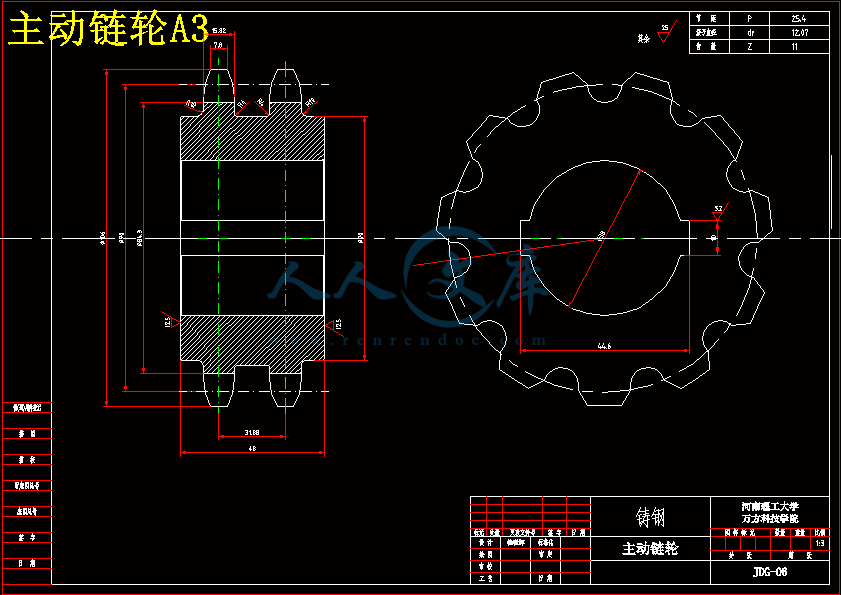新型甲带给料机设计
78页 27000字数+说明书+外文翻译+开题报告+6张CAD图纸【详情如下】
下平行托辊A3.dwg
中期检查表.doc
主动链轮A3.dwg
从动链轮A2.dwg
传动动滚筒A1.dwg
外文翻译--机器和机器零件的设计.doc
张紧装置A1.dwg
改向滚筒A1.dwg
新型甲带给料机设计开题报告.doc
新型甲带给料机设计说明书.doc
甲带给料机总装配图A1.dwg
缓冲托辊装置图A1.dwg
摘要
甲带给料机,是用作各种料仓的给料设备。广泛用于煤矿、冶金、电力等行业各种料仓的给料选料与配料。它克服了以往振动给料机与往复式给料机(K3、K4式)的能耗大、噪声大、机械在工作中易疲劳等缺点,具有给料量连续可调、能耗低、低噪声、连续平稳运行、无明显疲劳现象出现等优点,从而满足现场高效、节能、降耗、环保、便捷的要求。
其结构特征为:在料仓下导料槽的底部设一封闭的甲带,在一端甲带由驱动滚筒驱动,另一端设改向滚筒,中间设若干组托滚支承甲带;为取得更好的使用性能,可在甲带内设一封闭的胶带。本实用新型相比现有技术有以下优点:1.运行功率小,能量消耗少,运行经济性好;2.结构重量轻,造价低,运输方便;3.给料量大、稳定,且调整方便;4.运行平稳,噪音小,保护环境;5.磨损小,维修量小,使用寿命长;6.零部件通用性强,安装、维修简便;7.可更换现行的给料机。
关键词: 甲带给料机; 连续可调; 滚筒驱动; 优点; 维修简便。
Abstract
A belt feeder is used for a variety of silo feeding equipment. Widely used in mining, metallurgy, electric power and other industries a variety of silo feeding choice of materials and ingredients. It overcomes the previous feeder and the reciprocating feeder (K3, K4 type) of the energy consumption, noise, machinery at work, fatigue and other shortcomings, continuously adjustable with a feeding amount, low energy consumption, low noise and continuous smooth operation, no obvious fatigue phenomenon, etc., to meet the on-site efficiency, energy conservation, energy, environmental protection, convenience requirements. Its structure: in the bin located under the guide of a trough at the bottom of a closed zone, a zone at one end by a drive pulley drive, set up the other end of bend pulley, the middle set up a number of groups of support with roller bearing; to achieve more good performance can be equipped with a tape of a closed. The utility model has the following advantages compared to existing technology: 1. Operating power is small, less energy consumption, running economy is good; 2. Structure, light weight, low cost, easy to transport; 3. To the feeding amount large, stable, and easy adjustment; 4. Smooth running, low noise, protect the environment; 5. Wear a small, small amount of maintenance, long service life; 6. Parts versatility, installation, maintenance is simple; 7. Replaceable current feeder.
目录
绪论1
1 甲带给料机概述3
1.1 甲带给料机的应用3
1.2 给料机的分类及特点4
1.2.1 槽式给料机4
1.2.2 圆盘给料机5
1.2.3 摆式给料机5
1.2.4 振动给料机5
1.2.5 电磁振动给料机5
1.2.6 甲带给料机6
1.3 甲带给料机的发展状况6
1.4 甲带给料机的工作原理8
1.5 甲带给料机的结构9
2 甲带给料机的设计计算10
2.1 已知原始数据及工作条件10
2.2 计算步骤11
2.2.1 带宽的确定11
2.3 圆周驱动力15
2.3.1 计算公式15
2.3.2 主要阻力计算17
2.3.3 主要特种阻力计算19
2.3.4 附加特种阻力计算20
2.3.5 倾斜阻力计算21
2.4 传动功率计算22
2.4.1 传动轴功率()计算22
2.4.2 电动机功率计算22
2.5 输送带张力计算23
2.5.1 输送带不打滑条件校核23
2.5.2 输送带下垂度校核24
2.5.3 各特性点张力计算25
2.6 传动滚筒、改向滚筒合张力计算27
2.6.1 改向滚筒合张力计算27
2.6.2 传动滚筒合张力计算27
2.7 传动滚筒最大扭矩计算28
2.8 拉紧力计算28
2.9绳芯输送带强度校核计算29
3 驱动装置的选用与设计30
3.1 电机的选用30
4 甲带给料机部件的选用33
4.1 甲带33
4.1.1 甲带的分类33
4.1.2 甲带的连接35
4.2 传动滚筒36
4.2.1 传动滚筒的作用及类型36
4.2.2 传动滚筒的选型及设计37
4.2.3 传动滚筒结构38
4.2.4 传动滚筒的直径验算39
4.3 托辊40
4.3.1 托辊的作用与类型40
4.3.2 托辊的选型43
4.4拉紧装置45
4.4.1 拉紧装置的作用45
4.4.2 张紧装置在使用中应满足的要求46
4.4.3 拉紧装置在过渡工况下的工作特点46
4.4.4 拉紧装置布置时应遵循的原则47
4.4.5 拉紧装置的种类及特点47
5 其他部件的选用50
5.1 机架与中间架50
5.2 给料装置53
5.2.1 对给料装置的基本要求53
5.2.2 装料段拦板的布置及尺寸53
5.2.3 装料点的缓冲54
5.3 卸料装置55
5.4清扫装置56
5.4.1 篦子式刮板清扫装置56
5.4.2 输送机式刮板清扫装置57
5.4.3 刷式清扫装置58
5.4.4 振动式清扫装置59
5.4.5 水力和风力清扫装置60
5.4.6 联合清扫装置61
5.4.7 清扫装置的种类及应用情况分析61
5.5 头部漏斗67
5.6 电气及安全保护装置67
致? 谢69
参考文献71
甲带给料机是带式输送机的一种,是连续运行的运输设备,在冶金、采矿、动力、建材等重工业部门及交通运输部门中主要用来运送大量散状货物,如矿石、煤、砂等粉、块状物和包装好的成件物品。带式输送机是煤矿最理想的高效连续运输设备,与其他运输设备相比,不仅具有短距离、大运量、连续输送等优点,而且运行可靠,易于实现自动化、集中化控制,特别是对高产高效矿井,带式输送机已成为煤炭高效开采机电一体化技术与装备的关键设备。特别是近10年,大运量、高速度的带式输送机的出现,使其在矿山建设的井下巷道、矿井地表运输系统及露天采矿场、选矿厂中的应用又得到进一步推广。
选择甲带给料机这种新型机械的设计作为毕业设计的选题,能培养我们独立解决工程实际问题的能力,通过这次毕业设计是对所学基本理论和专业知识的一次综合运用,也使我们的设计、计算和绘图能力都得到了全面的训练。
原始参数:
1) 输送物料:煤
2) 物料特性:(1) 块度:0~80mm
(2) 散装密度:0.90t/m3
(3) 在输送带上堆积角:ρ=20°
(4) 物料温度:<50℃
3) 工作环境:井下
4) 输送系统及相关尺寸:(1) 运距:4m
(2) 倾斜角:β=0°
(3) 最大运量:350t/h
设计解决的问题:
熟悉甲带给料机的各部分的功能与作用,对主要部件进行选型设计与计算,解决在实际使用中容易出现的问题,并大胆地进行创新设计。
甲带给料机主要用于国民经济生产各部门物料传送系统中料仓的给料,它克服了目前给料系统中广泛使用的往复式和振动式给料机的缺点,改间断给料方式为连续给料方式,便恒定给料量为根据客户需要,大范围(给料量)动态连续可变给料,是给料系统更能满足高效、节能、环保的要求,此给料机可用于替换往复式和振动式给料机,还是用于跳汰机及装车仓的给料,此给料机可配备仓压检测装置,防止煤仓透风机物料对给料机的冲击。
目前,料仓给料系统中所使用的给料机主要有K型往复式和震动式给料机,两种给料方式的给料机,其结构和工作原理是:在料仓下部设一导料槽,导料槽底板为活动式,用一动力装置带动底板循环往复运动,当底板向给料口方向运行时,物料随底板一起运动,完成给料过程;当底板向反方向运行时,物料在内压力及内外摩擦力的共同作用下,物料并不随底板一起运动;底板不断循环往复运动,仓内物料不断的被送往出料口。两种给料方式的不同点是,给料频率和幅值及运动轨迹的不同。
K型往复式给料机的缺点是:给料机底板在回程中需要承受物料很大的摩擦力,所以需要较大的驱动功率,能耗大;由于功率大,结构受力也大,设备重量大;由于给料过程往复运动,设备震动大、噪音大;由于结构受力大,运动部件磨损快,维修量大;由于给料机不连续,生产率较低。
振动式给料机的缺点是;由于给料频率高,噪声大;由于是靠高频震动给料,其振幅和频率受物料粒度及比重影响较大,所以给料量不稳定,给料量的调整页比较困难;由于是靠振动给料,给料机必须起震并稳定在一定的频率和振幅,但振动参数对底板受力状态很敏感,故底板不能承受较大的仓压,需增加仓下导料槽的长度,结果是增加了料仓的整体高度,是成本加大;由于给料高度加大,无法用于替换目前大量使用的K型往复式给料机。
为克服上述给料机的缺陷,设计了一种甲带给料机,此给料机运行功率小,重量轻,给料量大,给料量稳定,调整方便,噪音小,维修量小,部件通用性强,且可用于更换目前正在使用的给料机的甲带给料机。
1.2.1 槽式给料机
槽式给料机可以架设于地面,也可以吊装在矿仓卸料口上。槽式给料机的槽体宽度约为给料最大粒度的2-2.5倍。最大的槽式给料机,可满足小于500mm粒度铁矿石的给矿。常选用的规格是980*1240槽式给料机,其给料粒度为350-0mm,适于作为400*600鄂式破碎机的给料设备。 槽底板作往复运动,其冲次为20-60次/min,冲程为20-200mm。冲程可由驱动装置偏心轮进行适当调整,偏心距为冲程之半。对于粘性矿石,偏心距不应小于30mm。
1.2.2 圆盘给料机
圆盘给料机是适用于20mm以下粉矿的给料设备。 圆盘式给料机由驱动装置、给料机本体、计量用带式输送机和计量装置组成。给料机和带式输送机由一套驱动装置驱动,该驱动装置的电磁离合器具有实现给料机的开、停和兼有功能转换的作用。计量带式输送机的带速小于1m/s,为了测定带速设有速度检测装置,为了防止称量辊偏斜设有检测杆进行调整。
1.2.3 摆式给料机
摆式给料机多作为球磨机集矿胶带输送机的给料设备。摆式给料机适用于选矿、选煤、化工及其他部门,将颗粒状物料从储料槽经漏斗送给各种类型的受料装置。摆式给料机不适宜输送干粉状或者太大粒度的物料,否则会出现粉尘污染及出料口堵塞现象1.3 甲带给料机的发展状况
短距离、大运量、高速是带式输送机的发展方向之一。与其他运输设备相比,带式输送机不仅具有短距离、大运量、连续运输的特点,而且运行可靠,易于实现自动化和集中控制,经济效益十分明显。所以在企业的生产过程中,凡能实现带式输送机输送的场合,一般都采用连续的带式输送机输送。与其他设备相比,带式输送机有以下优点:
(1) 输送物料种类广泛;
(2) 输送能力范围宽;
(3) 输送线路的适应性强;
(4) 灵活的装卸料,可以灵活实现一点或多点受料或卸料;
(5) 可靠性和安全性高;
(6) 费用低。
现代甲带带给料机的发展
(1) 智能化
为了适应高产高效集约化生产的需要,输送机的运输能力要加大,控制自动化水平要提高,高带速、大运量、大功率是带式输送机今后发展的必然趋势。
(2)提高关键零部件的性能和可靠性
设备开机率的高低主要取决于输送机关键零部件的性能和可靠性。而要提高关键零部件的性能和可靠性,除了进一步完善和提高现有零部件的性能和可靠性外,还要不断开发研究新的技术和零部件,如高性能可控软启动技术、动态分析与监控技术、高效储带装置、高寿命托辊等,使输送机的性能进一步提高。
(3) 扩大功能,一机多用化
甲带给料机是一种理想的连续中转运输设备,但目前其效能还没有充分发挥,资源有所浪费。如将带式输送机结构作适当修改,并采取一定的安全措施,就可拓展到运人、运料或双向运输等功能,做到一机多用,使其发挥最大的经济效益。
(4) 电控与监测自动化技术
为了实现输送机可控启动、中间驱动、功率平衡、带速同步、自动张紧以及各种保护装置、通信与信号联络等综合功能的要求,开发了1.4 甲带给料机的工作原理
料仓内的物料经连接段进入导料槽落在甲带上,甲带静止时物料最终靠内摩擦力而停止运动,在出料口形成一定角度的静止堆积;当驱动滚筒在外动力的驱动力下开始旋转时,带动胶带运动,胶带带动其上的物料导向出料口运行中的甲带在出料口卸料后转向回程,物料不断地从出料口排出,从而完成给料过程;二次密封装置对从导料槽和胶带之间间隙中露出的物料提供密封;粘结在甲带上未卸净物料在回程中,受重力、震动等因素的影响不断掉落于下护板上,而后又被甲带之甲片上凸起的刮料板再带回出料口重新卸料。改进进料口大小可通过闸板开度大小来实现;改变给料量,可以通过调节无级变速减速机的输出轴转速,来改变夹带运行速度的大小,从而改变给料量;改变给料量,也可以通过选配变频器,改变电动机转速,从而改变给料量。甲带给料机运行中,系统主要负荷均由滚筒轴承支撑,运行阻力小,设备所需驱动功率小,系统各零部件工作寿命长。5.5 头部漏斗
头部漏斗用于导料、控制料流方向的装置。也可起防尘作用。
(1) 本系列漏斗有普通型和调节挡板型(3型)两种。其中普通型又可分为不带衬板(1型)和带衬板(2型)两种。
带速范围:≤2.5m/s(1型),3.15m/s(2型),调节挡板式带速范围1.6~5m/s;2型漏斗在水平运输时可达4m/s。
(2) 订货时要注明清扫器的类型(重锤式或HP型刮板式等),以便确定漏斗上清扫器的安装孔。
(3) 选用本系列漏斗时,设计者还应根据输送机之间的搭接高度设计漏斗与导料槽之间的联接段。
5.6 电气及安全保护装置
安全保护装置是在输送机工作中出现故障能进行监测和报警的设备,可使输送机系统安全生产,正常运行,预防机械部分的损坏,保护操作人员的安全。此外,还便于集中控制和提高自动化水平。
(1) 电气及安全保护装置的设计、制造、运输及使用等要求,应符合有关国家标准或专业标准要求,如IEC439《低压开关设备和控制装置》;GB4720《装有低压电器的电控设备》;GB3797《装有电子器件的电控设备》。
(2) 电气设备的保护:主回路要求有电压、电流仪表指示器,并有断路、短路、过流(过载)、缺相、接地等项保护及声、光报警指示,指示器应灵敏、可靠。
(3) 安全保护和监测;应根据输送机输送工艺要求及系统或单机的工况进行选择,常用的保护和监测装置如下:
a.输送带跑偏监测:一般安装在输送机头部、尾部、中间及需要监测的点,轻度跑偏量达5%带宽时发出信号并报警,重度跑偏量达l 0%带宽时延时动作,报警、正常停机。
b.打滑监测:用于监视传动滚筒和输送带之间的线速度之差,并能报警、自动张紧输送带或正常停机。
c.超速监测:用于下运或下运工况,当带速达到规定带速的l15%~l25%时报警并紧急停机。
d.沿线紧急停机用拉绳开关,沿输送机全长在机架的两侧每隔60m各安装—组开关,动作后自锁、报警、停机。
e.其他料仓堵塞信号、纵向撕裂信号及拉紧、制动信号、测温信号等,可根据需要进行选择。
1.2.4 振动给料机
振动给料机又称振动喂料机。振动给料机可把块状、颗粒状物料从贮料仓中均匀、定时、连续地给到受料装置中去,在砂石生产线中可为破碎机械连续均匀地喂料,并对物料进行粗筛分,振动给料机广泛用于冶金、煤矿、选矿、建材、化工、磨料等行业的破碎、筛分联合设备中。 振动给料机(喂料机)性能特点:振动平稳、工作可靠、寿命长;可以调节激振力,可随时改变和控制流量,调节方便稳定;振动电机为激振源,噪声低,耗电小,调节性能好,无冲料现象。结构简单,运行可靠,调节安装方便,重量轻,体积小,维护保养方便,当采用封闭式结构机身时可防止粉尘污染。
1.2.5 电磁振动给料机
电磁振动给料机是一种较新型的定量给料设备,能适应于连续性生产的要求,其结构简单, 操作方便,不需润化,耗电量小;可以均匀地调节给矿量;因此已得到广泛应用,用于把块状、颗粒状及粉体状物料从贮料仓或漏斗中定量均匀连续地给到受料装置中,可作为带式输送机、斗式提升机、筛分设备水泥磨机、破碎机、粉碎机及各工业部门粘滞性的颗粒粉末状的供料装置;用于自动配料,定量包装等,并经可用于自动控制的流程中,实现生产流程的自动化。一般用于松散物料。广泛用于矿石、冶金、煤炭、建材、轻工、化工、电力、机械粮食、医药等工矿企业生产环节中。
1.2.6 甲带给料机
甲带给料机主要用于国民经济生产各部门物料传送系统中料仓的给料,甲带给料机为连续给料方式,恒定给料量刻根据客户需要,大范围(给料量)动态连续可变给料,是给料系统更能满足高效、节能、环保的要求,在煤矿中使用,可配备仓压检测装置,防止煤仓透风机物料对给料机的冲击。
甲带给料机的特点:运行功率小,重量轻,给料量大,给料量稳定,调整方便,噪音小,维修量小,部件通用性强。
参考文献
[1] 机械工程手册、电机工程手册编辑委员会.机械工程手册—机械产品(二)[M].机械工业出版社.1982年8月.
[2] 范祖尧等.现代机械设备设计手册—非标准机械设备设计[M].机械工业出版社.2000年6月.
[3] 唐金松.简明机械设计手册(第二版)[M].上海科学技术出版社.2002年6月.
[4] 北京起重机机械研究所、武汉丰凡科技开发有限责任公司.DTⅡ(A)型带式输送机机械设计手册[M].冶金工业出版社.2003年8月.
[5] 机械工业部设计单位联合设计组.ZJT1A-96带式输送机设计选用手册[M].黄河水利出版社.1998年10月.
[6] 机械化运输设计手册编委会.机械化运输设计手册[M].机械工业出版社.1997年5月.
[7] 张钺.新型带式输送机设计手册[M].冶金工业出版社.2001年2月.
[8]《运输机械设计选用手册》编组委.运输机械设计选用手册(上、下)[M].化学工业出版社.1999年1月.
[9] 毋虎城.矿山运输与提升设备[M].煤炭工业出版设.2004年5月.
[10] 上海煤矿机械研究所.煤矿机械设计手册[M].1972年.
[11] 于学谦.矿山运输机械[M].中国矿业大学出版社,1998年.
[12] 北起所.DTⅡ型带式输送机设计选用手册[M].冶金工业出版社.1994年.
[13] 北起所.DTⅡ型带式输送机平行轴驱动装置设计选用手册[M].机械工业部.1997年.
[14] 孔庆华,刘传绍.极限测量与测试技术基础[M].同济大学出版社.2002年.
[15] 机械设计手册编写组.机械设计手册[M].化学工业出版社.2002年.
[16] 中国纺织大学工程图学教研室.画法几何及工程制图[M].上海科技出版社.2000年.
[17] 张文芳,段志强,边会杰.带式输送机防跑偏辊及清扫器的使用与研究[J]. 河北煤炭.2002,5:9-10.
[18] 尹万涛,胡述记,米迎春.带式输送机自动调偏装置的改进设计[J].郑煤科技.2005,3:42-44.
[19] 李红玉.带式输送机自动调偏滚筒.矿业快报.2004,4(4):36.
[20] 张广文.起井下胶带输送机火灾事故的剖析与经验教[J].煤矿安全,2001,32(10):46-47.
[21] 李铁东,姜卫东.西沟矿下运带式输送机系统的设计及应用[J].煤矿机械,2004(9):8-9.
[22] 刘训涛,毛君.带式输送机断带抓捕器研究[J].矿山机械,2005(2):41-42.
[23]毛君,刘训涛.带式输送机断带保护系统的研究[J].煤矿机械,2004,(11):99-100.
[24] 陈炳耀,祁开阳.带式输送机输送带与滚筒之间的打滑分析[J].煤矿机械,2003(5):49-51.
[25] 罗云.21世纪安全管理科学展望[J].中国安全科学学报,2000,10(1):27-31.
[26] 禹金云.机械安全技术趋向分析[J].中国安全科学学报,2004,14(4):54-56.
[27] 王传海,张卫国.带式输送机断带及飞车制动保护装置[J].矿业安全与环保2003,30(3):40-46.
[28] 史志远,朱真才.带式输送机断带保护装置分析[J].煤矿机械,2005(8):83-85.
[29] 贺建华,鹿守明,丁永红.变频启动器在煤矿带式输送机上的应用[J].工矿自 动化.2006,12(6):56-58.
[30] 颜传宝,胡少银.软起动和液力偶合器配合使用及在带式输运机传动中的应用[J].煤矿机电.2003,334-36.








 川公网安备: 51019002004831号
川公网安备: 51019002004831号